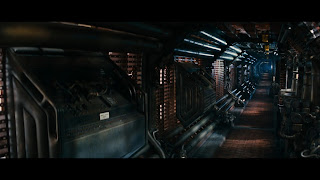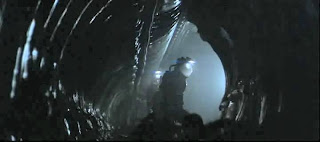Hello all,
I break my Lenten movie fast to bring you a (somewhat lengthy) discourse on Ridley Scott’s “Alien,” which I frequently use to answer those wondering what my favorite film is. My primary reason for doing so is its incredible production design, which has had almost incalculable influence on my artistic sensibility and served as inspiration for many design projects, personal and academic, over the years.
Many have heard of this film, but few these days seem to have actually seen it. For those uninitiated, the story is simple: a crew of astronauts on their way back to Earth divert from their course to investigate a mysterious signal coming from a distant planet. While exploring the surface, they find a crashed alien vessel that is filled to the brim with what appear to be eggs. When one of them hatches and the creature inside latches onto one of the crewmembers, they decide to bring their comatose comrade and his new “friend” back to their ship for study. As in many other horror films, this proves to be a huge mistake; before long, a big, deadly alien monster is stalking them through the corridors, and their only chance for survival is to corner and destroy it.
You can see why much is made of the fact that “Alien” was originally slated for production under a tiny budget and release as a “B-list” thriller. It certainly sounds like a cheesy 50’s monster film. But what elevated it above the status of pure schlock was Ridley Scott’s decision to pursue a grungier aesthetic than that of other science-fiction films of the time. This “used future” visual style was every bit as revolutionary as the visual effects in “Star Wars,” and as a result “Alien” has been frequently imitated over the decades (but never bettered).

The visual style of “Alien” bears special relevance to our recently completed project, which involved the design technique of “branding.” With the creation of his “used future,” Ridley Scott essentially developed a brand all his own. It would become a theme in several of his future films and remain a trademark of the “Alien” franchise in the three installments that succeeded his own. But it is even more interesting to note the parallels that Scott draws between different locations in “Alien.” The picture above is a still frame of one of the first shots in the film, as the human spacecraft Nostromo broods quietly, awaiting the awakening of its crew from stasis. Now check out the still frame below, taken from the sequence detailing the crew’s exploration of the alien craft:

Look at the highlights; look at the texture on the walls and the shape of the corridor as a whole. The design is more organic in nature than that of the human ship, but when you think about it the two are fairly analogous in terms of atmosphere and structure. Also compare the shapes in this shot of the cryosleep chamber (below)…
…to this shot of crewmember Kane inspecting the hatched egg just seconds before he is attacked (also below).

The canopies of the cryo tubes are designed to emulate flower petals, as are the textured panels on the bulkheads in the background… and, most disturbingly, as are the top edges of the grotesque, malevolent ovoid. I don’t know about the rest of you, but I get the sense that the production designers of “Alien” meant for these similarities to exist. Furthermore, I’d venture to claim that it is for this very reason (among others) that this film so utterly horrified audiences when it was released in 1979. We realize, even if only subconsciously, that the environment on board the Nostromo (even the more hospitable areas, like the cryosleep chamber) is not so very different from the environment on the alien vessel. When we later learn that a full sized monster is roaming about, then, this similarity instantly makes the once-innocuous (or at least recognizably human) interiors of the Nostromo terribly oppressive and threatening.

Of course, it also helps the utter destruction of our sense of security that Scott chooses to break from cliché and set the film’s most startling and infamous scene (it is frequently listed among the scariest in film history) in the crew dining room, which is one of the most brightly lit and apparently “safe” locations on board the ship. It is pictured above, as the surviving crew looks on in horror at the violent “birth” of the monster that will eventually grow to stalk them.
More importantly to the issue at hand, however, we see numerous examples of another strategy by Scott to sell his used future “brand.” He, like any good designer, knows that in order to create authenticity and consistency of vision (or even product, if you like), attention to detail is essential. For example, notice the irony implicit in the costume of Brett (second from the left). His official Nostromo cap (even complete with an official mission patch – someone designed that, too!) contrasts sharply with the flamboyant Hawaiian shirt that replaces, in his case, the more utilitarian white uniforms adorning the other three characters in the shot. Brett, like the ship, is part of the “used future”: regulation and protocol have been gradually thrown out the window as the months pass in endless spaceflight. See also the navigational logo signs on the bulkhead behind Captain Dallas (far right). Nostromo is shown throughout the film to be a cavernous ship, seemingly understaffed with only seven crewmembers to begin with. It logically follows, then, that directional cues would need to be given to crewmembers … but many lesser design teams might overlook this simple but helpful detail.
Truth is, I could easily see myself writing a year’s worth of papers on “Alien,” but I fear that I have already overstayed my welcome. Suffice it to say that this film is as good an example of a uniform artistic concept applied evenly to many different designs (or in this case locations and props) as any well-conceived soda package or what have you. Branding (in a loose definition of the term) is everywhere – even the movies.

















































